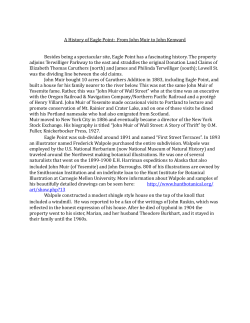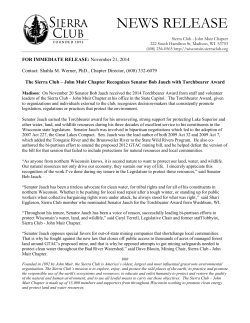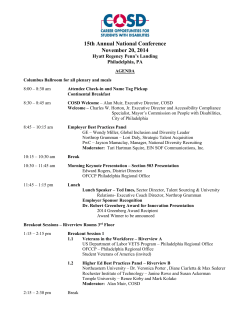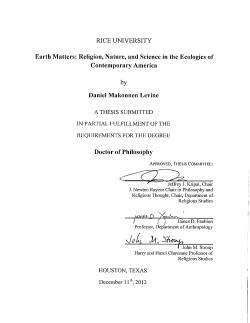
HERE - covoms356.org
Grade 6 -Community Unit Project
Directions: Choose l- of the 4 options for your community unit project.
Make sure to write a descriptive paragraph [5-7 sentences) to
accompany your project. In your paragraph describe your project and
details about how it represents your community. Be as creative as you
would like!
Project OPtions:
l--Create a Recipe book for your community [at least 5 recipes must be
included with pictures)
2-Make a video to showcase your community [include your narrationJ.
3-lnterview someone from your community (interview transcript of at
least 5 questions and answers are needed.
4-Create a diorama to represent your community (make sure to label all
parts and describe your project and how it represents your community)
*Due onL/5/1,5
r t+ r
'{
"i'
.::r:,:::..
:a:,":
t
a
t,
.{q
.*
f€*ril,
.lh;***;
'a
r:>
-.v
t*w"
tt*'#
e1f.; {F
a
+ .rt
I'
*
Read the passages. Then answer the questions that follow.
A Mountain Calling
by Amy Leinbach Marquis, National Parks
1
John Muir never liked the word "hike." Even in the 19th century, American societyt connection to
nature had grown increasingly shallow, people's time outdoors rigid and hasty. Muir, on the other hand,
preferred to saunter. "sauntering meant taking your time, valuing what you see," says Tad.Shay, lead
interpretive ranger at John Muir National Historic Site in Martinez, California. "It meant stopping to enjoy
the view of
2
a
lake, not running past it."
Born in 1838 in the seaside town of Dunbar, Scotland, Muir began his love affair with nature at a
youngage....
3
In
4
Muir was nearly 30 the first time
5
Muir quickly found work
a harsh farming life in America,
pastoral
It
wilderness-its open skies,
claiming an 8O-acre plot of land in central Wisconsin. was in this
frozenmeadows, and thousands of migrating birds-that Muir found his own religion. . . .
184%
Muirt father sacrificed the family's wealth in Dunbar for
into California's Sierra Nevada Mountains. He was
overwhelmed by the landscape, scrambling down steep clifffaces to get a closer look at the waterfalls,
whooping and howling at the vistas, jumping tirelessly from flower to flower. "We are now in the mountains
and they are in us, kindling enthusiasm, making every nerve quiver, filling every pore and cell of us," he wrote.
he ventured
as a sheepherder to keep this precious place near. Guiding his flock
through the foothills and into higher elevations, he began his lifelong courtship with the Sierra Nevada.
He spent much of his thirties alone in the mountains, carrying a tattered blue journal that he filled with
sketches, scientific observations, and soulful writing.
6
Although he preferred living on society's fringe, he also longed for human companionship. Muir
began publishing his writing in l9th-century travel publications that East Coast tourists read on trains bound
for the West. Soon, famous scientists and writers joined him in the Sierra Nevada. Ralph Waldo Emerson
affected Muir deeply. So did President Teddy Roosevelt, whom Muir invited on a camping trip in the sequoia
forest with one stipulation: No politics allowed. Roosevelt went on to establish Yosemite as a national park. . . .
7
Muir got the ball rolling for the National Park System," Shay says. Four more
significant designations would follow, thanks to Muir's influence: Grand Canyon, Mount Rainier, Petrified
Forest, and Sequoia. America would come to know Muir as "The Father of Our National Parks.l'
"Welike to
say that
8
In his 76 years, Muir published more than 300 articles andl2books. He moved a president to create
the U.S. Forest Service and co-founded the Sierra Club, which he$ed establish several new national parks
years after his death, and now boasts 1.3 million members.
9
l0
It's quite a legacy for a man who was so adamantr about taking his time.
"Our lives are so rapid these days," Shay says. "Perhaps the best way to honor Muir is simply to slow
down and appreciate nature for its beauty."
l adamant firmlyfixed
s@
g@
@Curriculum Associates, LLC
Albert Palmer was a companion of lohn Muir on several memorable "saunterings'l through the Sierras.
His memoir k a treasure of the early conservation movement in America.
from The Mountain Trail and lts Messoge
Excerpts
fromlhe Mountain Trail and Its Message
by
Albert W. Palmer
publishedby The Pilgrim Press, 1911.
1
There is a fourth lesson of the trail. It is one which John Muir taught me [during an early Sierra
Club outingl.
2
there are always qome people in the mountains who are known as "hikers." They rush over the trail
at high speed and take great delight in being the first to reach camp and in covering the greatest number of
miles in the least possible time. tThey] measure the trail in terms of speed and distance.
3
One day as I was resting in the shade Mr. Muir overtook me on the trail and began to chat in that
friendly way in which he delights to talk with everyone he meets. I said to him: "Mr. Muir, someone told me
you did not approve of the word'hike.' Is that so?" His blue eyes flashed, and with his Scotch accent he replied:
"I dont like either the word or the thing. People ought to saunter in the mountains-not hike!
4
"Do you know the origin of that word'saunter?' It's a beautiful word. Away back in the Middle Ages
people used to go on pilgrimages to the HolyLand, and when people in the villages through which they
passed asked where they were going, they would reply, A la sainte terre,' 'To the Holy Land.' And so they
became known as sainte-terre-ers or saunterers. Now these mountains are our Holy Land, and we ought to
saunter through them reverently, not 'hike'through them."
5
John Muir lived up to his doctrinel. He was usually the last man to reach camp. He never hurried.
He stopped to get acquainted with individual trees along the way. He would hail people passing by and make
them get down on hands and knees if necessary to see the beauty of some little bed of almost microscopic
flowers. Usually he appeared at camp with some new flowers in his hat and a little piece of fir bough in
his buttonhole.
6
Now, whether the derivationz of saunterMuir gave me is scientific or fanciful, is there not in it
another parable?3 There are people who "hike" through life. They measure life in terms of money and
amusement; theyrush along the trail of life feverishly seeking to make a dollar or gratify an appetite. How
much better to "saunter" along this trail of life, to measure it in terms of beauty and love and friendship! How
much finer to take time to know and understand the men and women along the way, to stop a while and let
the beauty of the sunset possess the soul, to listen to what the trees are saying and the songs of the birds, and
to gather the fragrant little flowers that bloom all along the trail of life for those who have eyes to see!
7
You cant do these things if you rush through life in a big red automobile at high speed; you can't
know these things if you "hike" along the trail in a speed competition. These are the peculiar rewards of the
man who has learned the secret of the saunterer!
t
2
3
doctrine: belief
derivation: origin
parable
a simple story
to illustrate
a
moral or spiritual lesson about life
Go On
B9
@Curriculum Associates, LLC
what does the author of "A Mountain Calling" suggest about John Muir's attitude about
ffi
;tl:iliql+ nature? Use two details from the passage to support your response.
Write your answer in complete sentences.
'.-t:ii.:.+\{
...'GS:* Albert w. Palmer states in paragraph 5 of The Mountain Trail and lts Message that "John Muir
i;ifi:+ lived up to his doctrine. " ln what ways did Muir do this? Use two details from the Passage to
supPort Your resPonse.
Write your answer in complete sentences.
+rO F:i
ln lhe Mountain Trail and lts Message, how does Albert W. Palmer reveal his point of view
regarding those who "hike" through life? Use two details from the passage to support
your response.
Write your answer in complete sentences.
Go On
&x
Planning Page
you may pLAN your writing for question 67 here if you wish, but do NOT write your final
answer on this page. Write your final answer on pages 43 and 44.
The authors of "A Mountain Calling" and lhe Mountain Trail and lB Message both present
John Muir's thoughts on the concept of "sauntering." From information in both passages,
what did "sauntering" mean to Muir and how he lived his life?
ln your response, be sure to do the following:
. describe how sauntering is presented in "A Mountain Calling"
. describe how sauntering is presented in lhe Mountain Trail and lB Message
. combine information from both passages to describe what sauntering meant to Muir
. use details from both passages in your response
Write your answer in complete sentences.
Go On
@Curriculum Associates, LLC
STOP
@Curriculum Associates, LLC
© Copyright 2025











